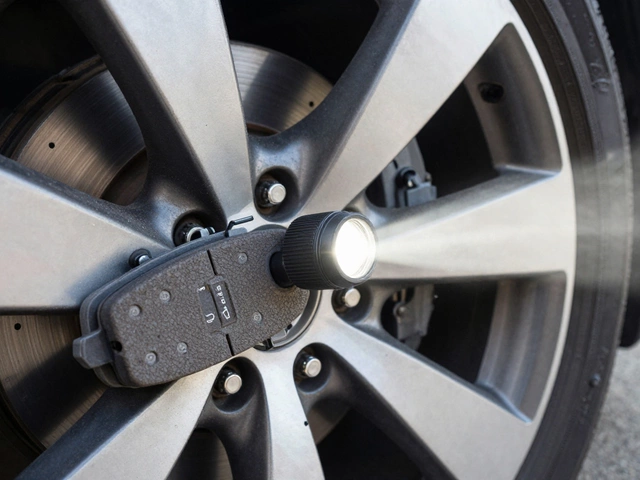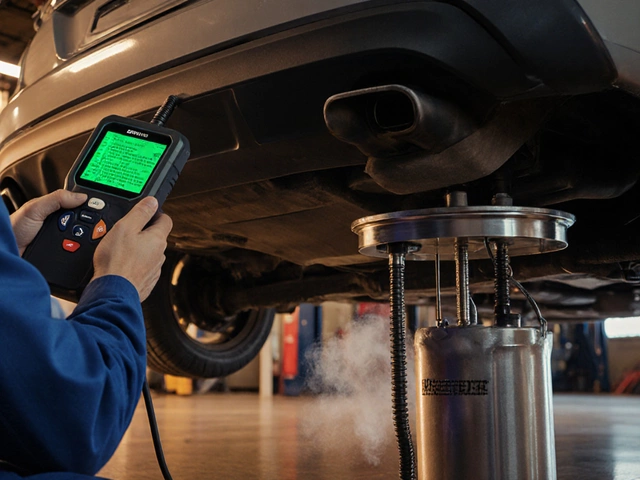Engine oil serves as the lifeline of your car's engine, keeping everything running smoothly by lubricating moving parts and reducing friction. As vital as it is, knowing the right time to change it can sometimes be tricky. But worry not, as there are a few telltale signs that suggest your engine oil needs some attention.
Among the most noticeable signs is the change in the oil's color. Fresh oil typically looks amber and clear, but over time, it turns darker and becomes less transparent as it accumulates dirt and debris. This darkened hue is a message from your engine that a change is overdue.
Another sign could be unusual noises from the engine. If you start to hear knocking or rumbling sounds, it could indicate that your oil isn’t as effective in lubricating as it should be. In some cars, a dashboard warning light is a direct plea from your vehicle to check the oil levels.
Understanding and recognizing these signs can prevent long-term damage to your engine. Keep a vigilant eye, and your car will thank you with years of reliable service.
- Understanding Engine Oil
- The Role of Engine Oil in Car Maintenance
- Common Indicators for an Oil Change
- Consequences of Ignoring Oil Change Signs
- How Often Should Engine Oil be Changed?
- Practical Tips for Regular Oil Maintenance
Understanding Engine Oil
At the heart of automotive maintenance lies a simple yet essential substance: engine oil. It performs the critical function of lubricating the moving components inside the engine, minimizing the friction that can otherwise lead to wear and tear. Think of engine oil as the unsung hero that keeps your car running smoothly and efficiently. Not only does it reduce friction, but it also helps in cooling the engine by dissipating heat as it circulates. Without this vital fluid, your vehicle’s engine would quickly overheat and seize, causing potentially irreparable damage. Engine oil has evolved significantly since its inception, with modern formulations offering enhanced protective qualities.
Today, several types of engine oils are on the market, each designed for specific purposes and vehicle types. These include conventional oil, synthetic oil, and blends of the two. Synthetic oils are manufactured to deliver superior performance, enduring harsh driving conditions and providing excellent protection at both high and low temperatures. Manufacturers typically recommend the type of oil best suited for your vehicle, found in the owner's manual or sometimes under the hood. This recommendation considers a multitude of factors, including engine design, driving conditions, and seasonal temperatures. Staying informed about the specific requirements for your car ensures optimal performance and longevity.
Understanding the viscosity grade of engine oil is equally important. Viscosity refers to how easily the oil pours at a specified temperature, usually indicated by numbers with a 'W' (which stands for winter) on the oil container, such as 10W-30. The first number indicates viscosity at low temperatures, crucial for cold starts and consistent engine lubrication during winter. The second number denotes viscosity at the engine's operating temperature. Choosing the right viscosity for your car can improve start-up lubrication, fuel consumption, and engine performance—especially in extreme weather conditions.
Apart from lubrication and cooling, engine oil plays a vital role in keeping the engine clean. It does this by trapping dirt, soot, and microscopic metal particles, all byproducts of combustion and engine wear. These impurities are carried away from critical areas to the oil filter, where they are captured. Over time, however, the oil becomes saturated with stored debris, which can lead to increased engine wear. This underscores the importance of regular oil changes. In the words of automotive specialist John Sullivan,
"Regular oil changes are the backbone of vehicle health, contributing significantly to the engine’s lifespan."It's a simple yet profound reminder that timely oil upkeep can save hundreds in potential repair costs.
Most drivers would be surprised to learn that engine oil even contributes to fuel efficiency. Proper lubrication means the engine doesn’t need to work as hard to overcome internal resistance, thus consuming less fuel. Some studies show that using the right type and grade of oil can improve fuel economy by about 2%. Though this might not seem much on a daily scale, it accumulates over time. If you're looking to save on fuel costs, ensuring your engine oil is in good condition can be an effective step. It's clearer now why so many car manufacturers stress the importance of adhering to recommended oil change intervals.
The Role of Engine Oil in Car Maintenance
Engine oil is much more than just a lubricant. It is the unsung hero of car maintenance, playing a crucial role in the health and longevity of your vehicle's heart—the engine. This magical concoction reduces friction among the countless components, ensuring they work harmoniously without wearing out prematurely. This is a big deal because the engine can reach temperatures as high as 250 degrees Fahrenheit. Without the calming effect of engine oil, metal parts would grind together, creating heat and potentially causing significant damage.
But that's not all. Engine oil also serves as a coolant and cleaner. As it circulates, it carries away the heat generated by the moving engine parts, preventing overheating. Simultaneously, it captures and holds onto impurities like dirt and tiny metal particles, keeping them suspended until the oil is changed and these contaminants are removed. This cleaning action is essential because accumulated gunk could erode engine surfaces over time.
"Regular oil changes are the single most important thing an owner can do to keep their vehicle healthy," says John Davis, host of MotorWeek.
Car maintenance is all about preventing problems before they arise, and engine oil is a key player in this regard. It creates a protective barrier between moving parts, lessening the risk of breakdowns and ensuring your car runs efficiently. The magic number often quoted for oil changes is every 3,000 miles, though the reality can vary based on the type of oil used and your driving habits. But ignoring the maintenance schedule can significantly decrease fuel efficiency, meaning more trips to the gas station. In terms of sheer numbers, keeping your oil fresh can improve efficiency by 1–2%. This might not sound like much, but it adds up over the lifespan of a vehicle.
What might go unnoticed is the oil's role in sealing. It fills the tiny gaps between pistons and cylinder walls, creating an airtight barrier. This improves compression, delivering more power and better performance. Not to mention, it helps in improving the car's emissions. Clean oil also contains additives designed to neutralize acids and reduce oxidative build-up, which can be especially beneficial in older engines.
Engine oil acts as both a protector and a restorer. Modern engines demand high-performance oils that not only protect but also adapt to changing conditions. Synthetic oils, for example, maintain viscosity at all temperatures, reducing wear during cold starts. They also resist thermal breakdown better than conventional oils, making them a wise choice for today's high-performance engines. A regular regimen of oil changes is the best form of preventive maintenance, ensuring a vehicle keeps purring smoothly down the road for years to come.
Embracing the habit of checking engine oil levels and conditions can turn a good car owner into a great one. It helps you understand your car, teaching when it needs attention and when it’s ready to hit the road. For many, taking a proactive approach to this seemingly simple task can make all the difference in their overall driving experience.

Common Indicators for an Oil Change
Recognizing the signs that your car needs an engine oil change can spare you a host of issues down the road. Cars have become smarter over the years, but they still rely on good, old-fashioned oil to keep humming. Let’s dive into some reliable indicators that it’s time for a change. One of the most conspicuous signs is when the oil itself starts to look different. Fresh oil is typically a golden amber color. However, with usage, it turns a darker shade due to the accumulation of tiny particles and debris. When you notice this change in hue, it's a good prompt to contemplate an oil change. Additionally, feel its consistency; oil that feels gritty to the touch signals unwanted particles are making their way through the engine which might harm it over time.
Aside from color and texture, pay attention to the sounds your engine is making. A healthy engine purrs, but if you start hearing knocking or otherwise unusual noises, the cause might be old, inefficient oil. In many cases, these noises arise because the oil is no longer able to adequately lubricate and cushion the engine's moving parts. As said by the experts at the American Automobile Association, "Ignoring the signs of needed maintenance can lead to larger issues down the line, emphasizing the fact that prevention is better than cure."
Your dashboard warning lights are high-tech allies in the quest for maintenance. Most vehicles today come equipped with an oil monitoring system, which adds another layer of assurance. If you see the oil change light or the check engine light illuminate, it's your car directly telling you it's time for an oil top-up or full change. Modern cars also often keep track of driving conditions, so even if you haven’t had a regular mileage-based reminder, the system might alert you based on recent driving patterns. Thus, it’s essential to pay heed to such signals promptly.
Moreover, frequent top-ups can also be an indicator. If you find you're needing to add oil regularly, more than what your manufacturer suggests, it might be time for a change. It indicates that the oil is breaking down too quickly, or there might be a leak leading to oil loss. Ensure you’re checking oil levels every few weeks to catch any sudden drops, and use that dipstick to gauge the health of your engine oil. Let's not forget the oil’s smell; oil that gives off a smoky or burnt aroma could spell trouble and certainly demands immediate attention.
Oil change frequency isn’t just random; it depends on various factors like the car's make and model, as well as the kind of driving you're doing. Please keep track of these signs, and ensure your engine achieves longevity with regular oil changes. Remember, being proactive about these indicators can save both time and money, keeping your relationship with your vehicle smooth and enjoyable.
Consequences of Ignoring Oil Change Signs
Ignoring the signs that your engine oil needs changing might seem like no big deal at first, but it carries significant risks for your car's health. Engine oil isn't just a lubricant; it plays a crucial role in reducing friction and ensuring all moving parts work together seamlessly. Without timely changes, the oil's ability to function properly degrades, allowing dirt and metal particles to accumulate. This accumulation chisels away at the engine's efficiency, making it more prone to overheating and wear, which might lead you down a potentially costly path of engine failure.
Driving with deteriorated oil will often result in reduced performance, lower fuel efficiency, and might even lead to a more aggressive wear-and-tear on engine components. This kind of continuous stress on the engine not only shortens its lifespan but can end with complete engine breakdown. The cost of ignoring such maintenance could result in hundreds, if not thousands, of dollars in repairs, often leaving car owners to face the daunting decision of whether to repair or replace the vehicle. Hence, it’s clear that saving a few bucks on an oil change today might lead to disproportionately higher expenses tomorrow.
Remarkable research has shown that regular oil changes can improve a vehicle's fuel consumption by 1% to 2% on average, as reported by the U.S. Department of Energy.
"Changing your oil regularly is akin to going to the doctor for regular check-ups. The small costs up front can prevent much larger expenses down the road," notes automotive expert John Ibbotson from Consumer Reports.As convincing as that sounds, the reminder is that delay and negligence in addressing oil change signs don’t just impact your wallet but also impact the environment by contributing to increased emissions when an inefficient engine runs overworked.
In summary, neglecting to change engine oil in the face of evident signs, like dirty or low levels of oil, is akin to ignoring a ticking time bomb under your hood. It invites a cascade of adverse effects: poor engine performance, costly repairs, potential engine failures, and needless environmental harm. It’s not just about maintaining the car; it’s about averting unnecessary risks synonymous with automobile ownership. So, take heed of those signals and ensure that your oil change routine is as regular as clockwork.

How Often Should Engine Oil be Changed?
The frequency of changing your engine oil is a topic that often spurs debate among drivers and mechanics alike. Traditionally, the rule of thumb was to replace the oil every 3,000 miles. But advancements in both car technology and oil formulations have led to recommendations extending to between 5,000 to 7,500 miles for most vehicles. Of course, this varies based on the make and model of your car, and the type of oil you use.
Modern vehicles often come with an onboard maintenance minder that monitors engine conditions and driving habits to predict when the oil change is needed. Such systems let you stretch your oil's lifespan while maintaining optimal engine health. So, it’s worth consulting your car’s manual or discussing with a trusted mechanic to understand what’s best for your vehicle.
Interestingly, synthetic oils, which are a favorite among car enthusiasts, can extend the interval even further. They not only withstand longer intervals but also perform better under extreme temperatures and driving conditions. A well-maintained schedule using synthetic oil could push your oil change requirements to every 10,000 miles or even further, making them a valuable choice for those who travel frequently.
If you often find yourself in the middle of stop-and-go traffic, drive mostly short distances, or live in an area where temperatures regularly hit extremes, you might need to change your oil more often. Each of these factors puts additional stress on your vehicle's engine, which in turn requires more frequent maintenance to keep it purring smoothly.
Let's not forget that some manufacturers and oil change services also suggest seasons could influence how often you change your engine oil. For instance, severe winter conditions or the scorching summer sun could demand more regular oil evaluations.
"Adhering to an oil change schedule based on your unique driving patterns and conditions can prolong the life of your engine," emphasizes John Davis, a respected auto mechanic and writer for 'Motor Weekly'.
Lastly, newer cars equipped with oil-life monitoring systems can provide real-time insights, making “one-size-fits-all” advice obsolete. These systems take into account various parameters such as engine revolutions, heat generated, and operating conditions to notify you exactly when it’s time to replace that vital engine lifeline.
Practical Tips for Regular Oil Maintenance
Staying on top of engine oil maintenance is like giving your car the gift of long life and efficiency. Many car owners underestimate the simple act of regular oil checks, yet it plays a pivotal role in the health of their vehicles. The first step is to know your vehicle's oil needs. Different vehicles require different types of oil, varying in viscosity and additives. Always refer to the owner's manual, which is a treasure trove of specifications about not just the right type of oil, but also the maintenance intervals. Doing so ensures your engine runs with the fluid consistency it needs, preventing issues that could arise from using the wrong oil type.
Developing a routine check is where the magic begins. Make it a habit to check your oil levels at least once a month. This can be done easily with the dipstick approach, a timeless method that has helped drivers for decades. Simply let the engine cool, pull out the oil dipstick, wipe it clean, reinsert, and pull it out again to see the level. If it’s below the required mark, it's time to top it off or consider a change engine oil if it appears dirty or thick. Remember, a clean dipstick means a clean slate, each time you check.
In addition to regular checks, always keep an eye on your mileage. Most experts agree change intervals are best adhered to every 3,000 to 5,000 miles, but some modern synthetic oils promise a span of up to 10,000 miles. This largely depends on the conditions your vehicle faces. Cars driven mostly in urban environments demand more frequent oil changes due to stop-and-go traffic increasing engine load, compared to open road drives. Knowing your driving pattern is knowing your oil cycle.
Another often overlooked tip is too obvious not to mention: ensure your oil filter is changed with every oil change. The filter plays a crucial role in trapping debris and preventing it from circulating back into the engine. Reusing an old filter with fresh oil is akin to cleaning a glass with murky water; it simply doesn’t help. Now let’s mention additives, the popular quick-fixes for many car enthusiasts. While some swear by certain brands boosting engine performance, it’s essential to be cautious. The best practice is to consult your mechanic for advice tailored to your engine's specific needs.
According to the American Petroleum Institute, "Many oil-related engine problems can be averted through diligent maintenance, and only 40% of drivers adhere to the recommended schedules." This highlights an astounding gap between knowledge and practice, underlining the importance of discipline in oil upkeep.
Lastly, stay informed about any potential oil recalls or service advisories related to your vehicle's make and model. Such announcements can affect oil performance and, ultimately, your car’s health. Engaging with car maintenance forums or subscribing to newsletters can also be invaluable sources of contemporary advice and tips, often coming from fellow car lovers who've shared in the trials and triumphs of vehicle maintenance. Remember, a well-maintained car not only promises reliability but also performance that meets its capability to the fullest.




